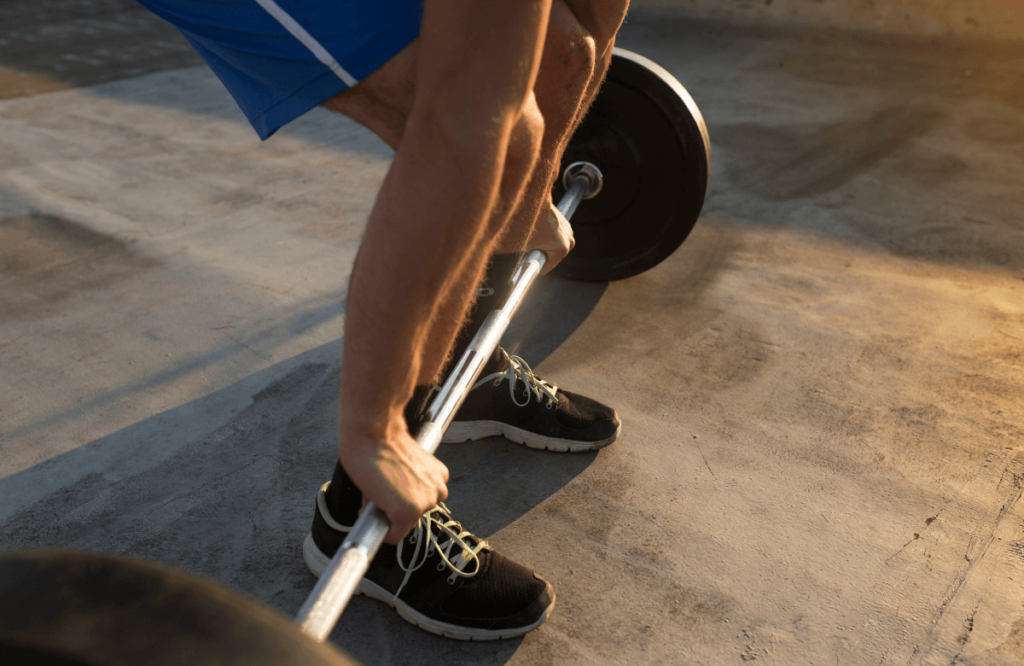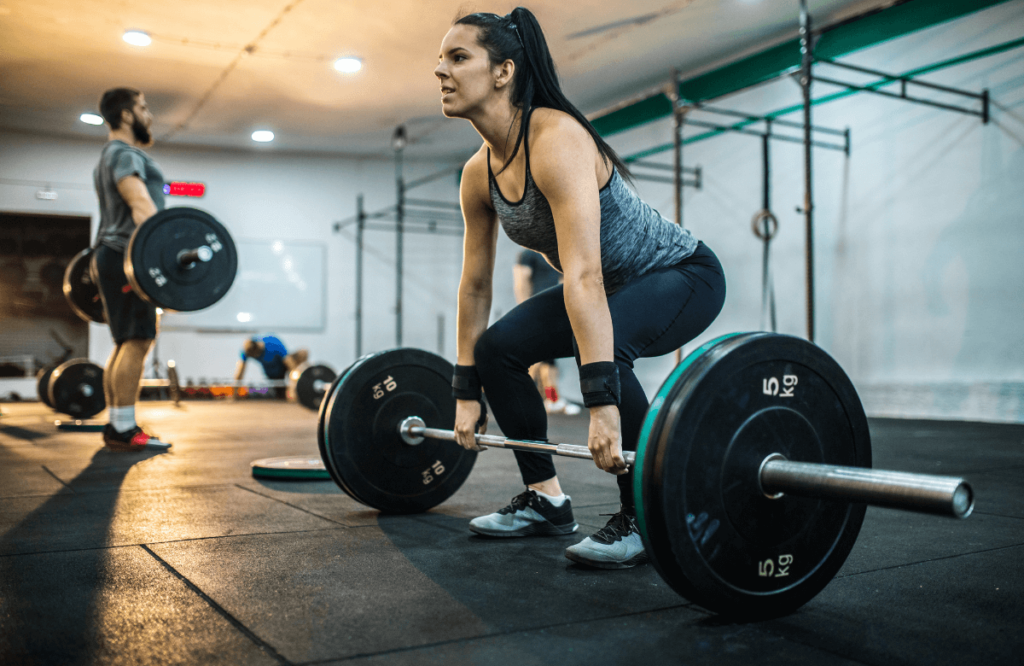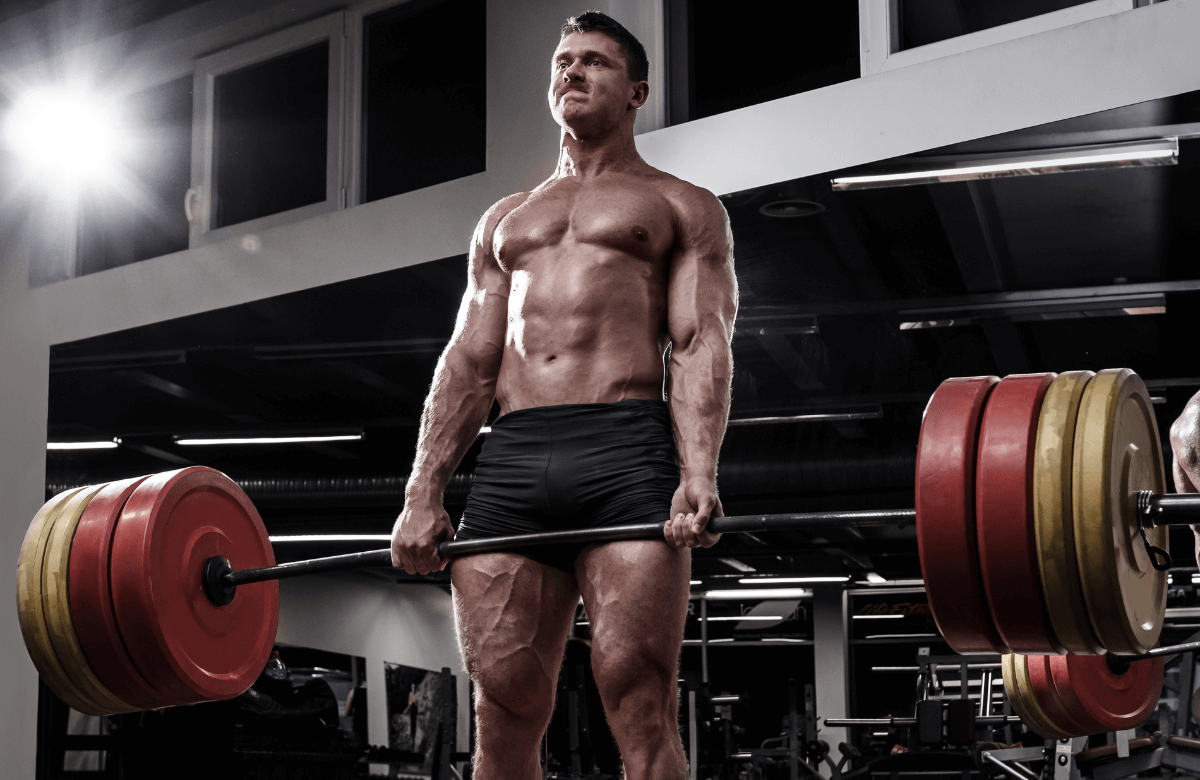The deadlift is the gold standard when it comes to compound movements. The foundational exercise develops the lower body and functional strength. But have you tried variations like the stiff leg deadlift?
With a few adjustments to your form, the stiff leg deadlift can be a new tool in your arsenal for targeting individual hamstring muscles and building strength. Let’s look at everything you need to know about the movement and how you can get started.
The stiff leg deadlift is a variation of the traditional deadlift that emphasizes the Posterior Chain muscles, lower back, hamstrings, and glutes. As you might imagine, the movement requires you to perform a deadlift with straight or stiff legs. The range of motion is shorter, and there’s less hinge in the knees when performing a stiff leg deadlift.
The exercise requires a bit of mobility to avoid rounding your back excessively. Many enthusiasts recommend raising the barbell on blocks, plates, or a rack to reduce the range of motion to a more manageable level.
Jump to:
How to Perform the Stiff Leg Deadlift
The starting position is the critical difference between the stiff leg and traditional deadlift. Regular deadlifts allow for more knee-bending, while stiff legged deadlifts require straight legs.
It can be challenging to reach the starting position of the movement while maintaining a straight back or slight arch, depending on your fitness levels. In these cases, you can place the barbell on low blocks or a few 45lb plates to decrease the range of motion. You remove any supports as you improve your mobility and technique.
Here’s how to perform the stiff legged deadlift:
- Place the barbell on the ground in front of you. Step up to the bar and stop when it’s over the middle of your foot. Your feet should be shoulder-width apart.
- Take a deep breath and lean forward to grip the bar. Ensure there’s only a slight bend in your knees, and maintain a tight back.
- Without exhaling, tighten your core, and lift the barbell.
- Pull the bar up your body. Maintain a straight back until you’re in a standing position.
- Now, slowly lower the barbell toward the ground while keeping your legs straight.
- Take another inhale and repeat the movement for additional reps.

How to Raise the Barbell to Decrease the Range of Motion
The range of motion of the stiff legged deadlift can be challenging at first, depending on your mobility. As mentioned earlier, you can start the stiff legged variation raised off the ground to reduce the difficulty. Let’s take a look at some of the ways you can lift the barbell:
- Rack Pulls: You can set the barbell on the safety rails of a squat or power rack. This will reduce the range of motion, but be sure to prioritize your technique. If you bend your legs too much, you’ll do standard deadlifts.
- On 45lb Plates: Another way to raise the barbell is to place the weights on 45lb plates flat on the ground. This option might be best suited for home gyms or when there are few people in the gym.
- Pulling Blocks: You can find metal or wooden pulling blocks online and at some gyms. These can be useful for decreasing the range of motion in various lifts. Pulling blocks is a fantastic solution if you have access to them.
Avoid These Mistakes
Just like the conventional deadlift—or any movement, for that matter—there are common mistakes that can lead to bad habits, overexertion, and injury. Avoiding these mistakes will prevent damage and ensure you use the correct muscles. Let’s take a deeper look.
Don’t Round Your Back
A rounded or bent back is a common mistake for standard deadlifts and variations. Rounding your back during the movement can seriously strain your lower back and cause injury to the erector spinae muscles.
Instead, ensure that your core is tight and your shoulders are back before starting the lift. You can use several cues to maintain the proper form, but be sure to keep your chest up and look forward instead of down.
Don’t Let the Bar Drift From Your Body
Whether you’re doing a conventional deadlift, stiff legged deadlift, or Romanian variation, the bar must be close to your body. Letting the bar drift away from you requires you to spend more energy to pull it. Not only does this increase fatigue, but it uses less efficient muscle activation and can lead to strains or injuries.
Instead, ensure the bar is touching your shins as you pull it upward. This will reduce the range of motion and provide the most effective path for the weight to travel. You can wear pants or high socks if the barbell has knurling that causes friction burns.
Don’t Overextend Your Neck
Overextending the neck is another way to cause strain or injury. It’s easy to fall into the habit of tightening your neck and looking upward while performing a deadlift. Instead, keep your neck in a relaxed position and look straight ahead. This will help you avoid straining your shoulders or neck.

Avoid Bending Your Knees
It’s called a stiff leg deadlift for a reason, right? Too much bend in the knees while performing this variation will turn it into a conventional deadlift. The straight-leg variation requires a bit more mobility, so you might want to raise the bar on blocks or weights until your technique improves.
What Muscles Does the Straight Leg Deadlift Activate?
Straight-leg deadlifts target the same muscle groups similarly to conventional deadlifts. That said, the movement prioritizes the Posterior Chain and can improve your regular deadlift. Let’s look at the primary and secondary muscle groups the exercise targets.
Primary Muscles
The stiff leg variation places a greater emphasis on the Posterior Chain. The Posterior Chain comprises the calves, hamstrings, gluteus maximi, latissimus dorsi, and erector spinae muscles. The primary muscles activated in the stiff leg deadlift include the following:
- Hamstrings
- Glutes
- Lower Back Muscles
All deadlifts are compound movements, meaning they activate multiple muscle groups at the same time. The glutes are most engaged during the stiff leg variation, and less emphasis is placed on the quads.
The stiff variation also activates the individual hamstring muscles, making it a fantastic lower-body exercise. The straight-leg deadlift is an excellent accessory movement, as it helps you target weaker muscles in your body.
Secondary Muscles
Like the standard deadlift, the straight leg variation also targets the upper body, middle back, and core muscles. The stiff legged variation targets the following secondary muscles:
- Adductors
- Trapezius
- Forearm Flexors
The trapezius muscle is the primary, secondary muscle activated, as it helps you stabilize the bar during the movement. Core muscles, like the abdominals and obliques, also work as stabilizers. Lastly, the biceps and middle back help you move the barbell in the correct path.

Why Should You Do the Straight Leg Deadlift?
The straight-leg deadlift looks slightly different from the normal movement, so why would you add this to your program? Although it’s a slight difference, the straight leg variation provides unique benefits that can improve your strength and deadlift capabilities.
Improve Leg Strength
It’s no secret that the deadlift targets the lower body. However, the stiff leg variation activates them differently than the standard form. Less emphasis is placed on the quads, as you can’t hinge your knees to lift the weight. The stiff variation targets the glutes, individual hamstrings, and calves, making it a leg-dominated movement.
Many lifters prefer to program the stiff leg variation into their leg days or as an accessory to their regular deadlift for these reasons.
Enhance Functional Strength
Regular deadlifts and variations improve functional strength. Functional strength refers to one’s ability to complete everyday activities like squatting, reaching over, and picking things up. With greater functional strength, you can perform daily tasks more easily and reduce the risk of injury.
More specifically, the straight-leg variation can improve your hip-hinging abilities and reduce the risk of a knee injury. The variation places less emphasis on the knees and strengthens the hamstrings, which helps prevent future injuries.
Add Cross-Over Training For the Barbell Deadlift
Did you hit a plateau with the barbell deadlift? Try variations like straight-legged or Romanian deadlifts. The stiff deadlift targets similar muscles but doesn’t use the quads like the normal variation. This movement pattern allows you to activate the weakest muscles in your Posterior Chain, like the glutes, calves, and hamstrings.

Straight Leg Deadlift Variations to Consider
There are several straight-leg deadlift variations you can incorporate into your workout routine. Many of these movements target similar body muscles but can be executed with heavy and light weights. Let’s take a look below.
Dumbbell Stiff Leg Deadlift
The dumbbell stiff leg deadlift is one of the most straightforward variations. Dumbbells allow you to use less weight and keep the weight closer to your body, which reduces pressure on the lower back. You might substitute this exercise if you have low back injuries, don’t have access to a barbell, or need a lightweight day.
Romanian Deadlifts
Many people assume straight-leg and Romanian deadlifts are identical. This is a misconception. Straight-leg deadlifts don’t require any hip hinge movements. RDLs require much more hip hinge movement. This key difference allows you to lift heavier weights and develop muscle strength.
Hip Thrusts
Straight-leg deadlifts can place pressure on the lower back, making them less suited for certain lifters and applications. The pressure on the lower back is exasperated if you have poor flexibility in the hamstrings.
Hamstring muscle strains increase the risk of arching the lower back, which can cause injury strains.
What’s an alternative? Hip thrusts! Hip thrusts work similarly to primary movers but don’t place as much strain on the lower back. Furthermore, you can use additional weights and easily fit them into your training program.
Kettlebell Swings
Kettlebell swings are a versatile hip hinge movement that uses momentum, unlike the straight-leg or barbell deadlift. Lifting the kettlebell quickly can increase strength, burn calories, and improve endurance. Not to mention, they’re fun and excellent for targeting the individual hamstring muscles.
Frequently Asked Questions (FAQ)
What’s Better, Deadlift or Stiff Leg Deadlift?
The stiff leg deadlift requires straight legs and activates the muscles in your hamstrings, glutes, and calves more than a regular deadlift. Neither option is better, but the stiff leg deadlift can be used to improve weaker muscles and improve function alongside explosive strength.
What Are stiff leg Deadlifts Good For?
The straight-leg deadlift is an isolation exercise that targets hip flexion and extension. It’s an excellent movement for improving lower body strength. You can program stiff legged variations as an accessory movement or as a way to put less strain on your knees during standard deadlifts.
Is the stiff leg Deadlift the Same as the RDL?
No, the stiff legged deadlift and the Romanian deadlift are two different variations. The stiff leg variation prioritizes the hamstrings, hip flexion, and extension. Romanian deadlifts require you to stop the bar around shin height, and the plates don’t touch the ground between reps.















